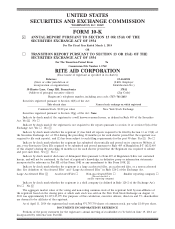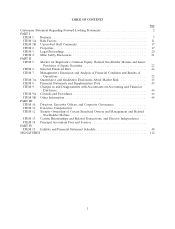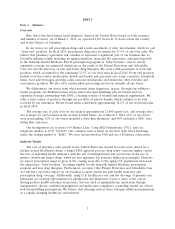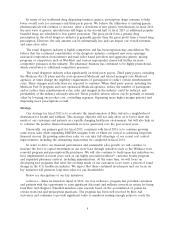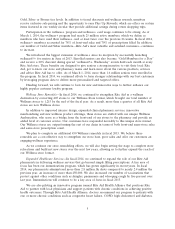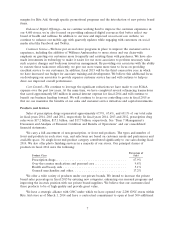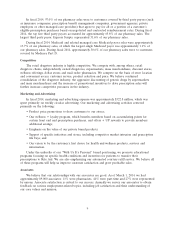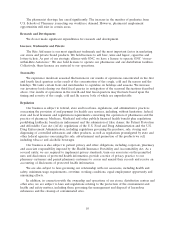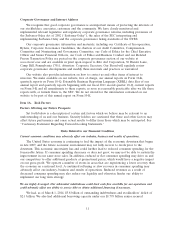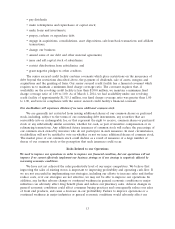Rite Aid 2014 Annual Report Download - page 4
Download and view the complete annual report
Please find page 4 of the 2014 Rite Aid annual report below. You can navigate through the pages in the report by either clicking on the pages listed below, or by using the keyword search tool below to find specific information within the annual report.PART I
Item 1. Business
Overview
Rite Aid is the third largest retail drugstore chain in the United States based on both revenues
and number of stores. As of March 1, 2014, we operated 4,587 stores in 31 states across the country
and in the District of Columbia.
In our stores, we sell prescription drugs and a wide assortment of other merchandise, which we call
‘‘front-end’’ products. In fiscal 2014, prescription drug sales accounted for 67.9% of our total sales. We
believe that pharmacy operations will continue to represent a significant part of our business due to
favorable industry trends, including an aging population, increased life expectancy, anticipated growth
in the federally funded Medicare Part D prescription program as ‘‘baby boomers’’ start to enroll,
expanded coverage for uninsured Americans as the result of the Patient Protection and Affordable
Care Act and the discovery of new and better drug therapies. We carry a full assortment of front-end
products, which accounted for the remaining 32.1% of our total sales in fiscal 2014. Front-end products
include over-the-counter medications, health and beauty aids, personal care items, cosmetics, household
items, food and beverages, greeting cards, seasonal merchandise and numerous other everyday and
convenience products. We also offer various photo processing services in virtually all our stores.
We differentiate our stores from other national chain drugstores, in part, through our wellness+
loyalty program, our Wellness format stores, innovative merchandising, private brands and our
expanded strategic partnership with GNC, a leading retailer of vitamin and mineral supplements. We
offer a wide variety of products through our portfolio of private brands, which continue to be well
received by our customers. Private brand items contributed approximately 18.2% of our front-end sales
in fiscal 2014.
The average size of each store in our chain is approximately 12,600 square feet, and average store
size is larger for our locations in the western United States. As of March 1, 2014, 61% of our stores
were freestanding; 52% of our stores included a drive-thru pharmacy; and 48% included a GNC store
within Rite Aid store.
Our headquarters are located at 30 Hunter Lane, Camp Hill, Pennsylvania 17011, and our
telephone number is (717) 761-2633. Our common stock is listed on the New York Stock Exchange
under the trading symbol of ‘‘RAD.’’ We were incorporated in 1968 and are a Delaware corporation.
Industry Trends
The rate of pharmacy sales growth in the United States has slowed in recent years, driven by a
decline in new blockbuster drugs, a longer FDA approval process, drug safety concerns, higher copays,
the loss of individual health insurance with the rise of unemployment and an increase in the use of
generic (non-brand name) drugs, which are less expensive but generate higher gross margins. However,
we expect prescription usage to grow in the coming years due to the aging U.S. population, increased
life expectancy, ‘‘baby boomers’’ becoming eligible for the federally funded Medicare prescription
program and new drug therapies. Furthermore, we expect that Patient Protection and Affordable Care
Act will have a positive impact on our business as more Americans gain health insurance and
prescription drug coverage. Additionally, rising U.S. healthcare costs and the shortage of primary care
physicians are creating opportunities for pharmacists and drugstores to play a more active role in
driving positive health outcomes for patients. Services such as immunizations, medication therapy
management, chronic condition management and medication compliance counseling extend our efforts
well beyond filling prescriptions. We believe that offerings such as these will gain additional momentum
in a rapidly changing healthcare environment.
3

